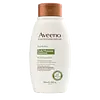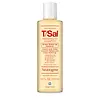What's inside
What's inside
 Key Ingredients
Key Ingredients

No key ingredients
 Benefits
Benefits

 Concerns
Concerns

 Ingredients Side-by-side
Ingredients Side-by-side

Colloidal Oatmeal Extract
HumectantWater
Skin ConditioningSodium C14-16 Olefin Sulfonate
CleansingCocamidopropyl Betaine
CleansingGlycol Distearate
EmollientHydrolyzed Milk Protein
Skin ConditioningPrunus Amygdalus Dulcis Seed Extract
Skin ConditioningPEG-7 Amodimethicone
HumectantPolyquaternium-22
Polyquaternium-39
PEG-150 Pentaerythrityl Tetrastearate
EmulsifyingPPG-2 Hydroxyethyl Cocamide
EmulsifyingAcrylates/C10-30 Alkyl Acrylate Crosspolymer
Emulsion StabilisingLaureth-4
EmulsifyingSodium Hydrolyzed Potato Starch Dodecenylsuccinate
Linoleamidopropyl Pg-Dimonium Chloride Phosphate
Propylene Glycol
HumectantCitric Acid
BufferingSodium Citrate
BufferingHexylene Glycol
EmulsifyingSodium Hydroxide
BufferingSodium Benzoate
MaskingParfum
MaskingColloidal Oatmeal Extract, Water, Sodium C14-16 Olefin Sulfonate, Cocamidopropyl Betaine, Glycol Distearate, Hydrolyzed Milk Protein, Prunus Amygdalus Dulcis Seed Extract, PEG-7 Amodimethicone, Polyquaternium-22, Polyquaternium-39, PEG-150 Pentaerythrityl Tetrastearate, PPG-2 Hydroxyethyl Cocamide, Acrylates/C10-30 Alkyl Acrylate Crosspolymer, Laureth-4, Sodium Hydrolyzed Potato Starch Dodecenylsuccinate, Linoleamidopropyl Pg-Dimonium Chloride Phosphate, Propylene Glycol, Citric Acid, Sodium Citrate, Hexylene Glycol, Sodium Hydroxide, Sodium Benzoate, Parfum
 Reviews
Reviews

Ingredients Explained
These ingredients are found in both products.
Ingredients higher up in an ingredient list are typically present in a larger amount.
Citric Acid is an alpha hydroxy acid (AHA) naturally found in citrus fruits like oranges, lemons, and limes.
Like other AHAs, citric acid can exfoliate skin by breaking down the bonds that hold dead skin cells together. This helps reveal smoother and brighter skin underneath.
However, this exfoliating effect only happens at high concentrations (20%) which can be hard to find in cosmetic products.
Due to this, citric acid is usually included in small amounts as a pH adjuster. This helps keep products slightly more acidic and compatible with skin's natural pH.
In skincare formulas, citric acid can:
While it can provide some skin benefits, research shows lactic acid and glycolic acid are generally more effective and less irritating exfoliants.
Most citric acid used in skincare today is made by fermenting sugars (usually from molasses). This synthetic version is identical to the natural citrus form but easier to stabilize and use in formulations.
Read more about some other popular AHA's here:
Learn more about Citric AcidCocamidopropyl Betaine is a fatty acid created by mixing similar compounds in coconut oil and dimethylaminopropylamine, a compound with two amino groups.
This ingredient is a surfactant and cleanser. It helps gather the dirt, pollutants, and other impurities in your skin to be washed away. It also helps thicken a product and make the texture more creamy.
Being created from coconut oil means Cocamidopropyl Betaine is hydrating for the skin.
While Cocamidopropyl Betaine was believed to be an allergen, a study from 2012 disproved this. It found two compounds in unpure Cocamidopropyl Betaine to be the irritants: aminoamide and 3-dimethylaminopropylamine. High-grade and pure Cocamidopropyl Betaine did not induce allergic reactions during this study.
Learn more about Cocamidopropyl BetaineHexylene Glycol is a surfactant. Glycols are a class of alcohols. Hexylene Glycol is a surfactant and emulsifier.
As a surfactant, Hexylene Glycol helps gather dirt and oil on your skin to be washed away.
As an emulsifier, Hexylene Glycol helps keep water and oil together. This prevents them from separating in a product. Hexylene Glycol also thins out the texture of a product by lessening viscosity.
Hexylene Glycol has a small molecular weight.
Learn more about Hexylene GlycolWe don't have a description for Linoleamidopropyl Pg-Dimonium Chloride Phosphate yet.
We don't have a description for Polyquaternium-22 yet.
Sodium C14-16 Olefin Sulfonate is a cleansing agent made from a mixture of long chain sulfonate salts. It can also help produce foam.
This ingredient may be drying. We recommend speaking with a professional if you have concerns.
Sodium Citrate is the sodium salts of citric acid. In skincare, it is used to alter pH levels and acts as a preservative.
Its main functions are to maintain the pH of a product and neutralize metal ions.
The acidity of our skin is maintained by our glands and skin biome; normal pH level of skin is slightly acidic (~4.75-5.5).
Being slightly acidic allows our skin to create an "acid mantle". This acid mantle is a thin barrier that protects our skin from bacteria and contaminants.
Learn more about Sodium CitrateSodium Hydroxide is also known as lye or caustic soda. It is used to adjust the pH of products; many ingredients require a specific pH to be effective.
In small amounts, sodium hydroxide is considered safe to use. However, large amounts may cause chemical burns due to its high alkaline.
Your skin has a natural pH and acid mantle. This acid mantle helps prevent harmful bacteria from breaking through. The acid mantle also helps keep your skin hydrated.
"Alkaline" refers to a high pH level. A low pH level would be considered acidic.
Learn more about Sodium HydroxideWater. It's the most common cosmetic ingredient of all. You'll usually see it at the top of ingredient lists, meaning that it makes up the largest part of the product.
So why is it so popular? Water most often acts as a solvent - this means that it helps dissolve other ingredients into the formulation.
You'll also recognize water as that liquid we all need to stay alive. If you see this, drink a glass of water. Stay hydrated!
Learn more about Water